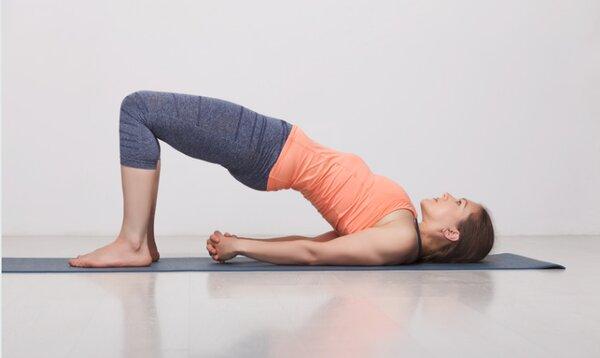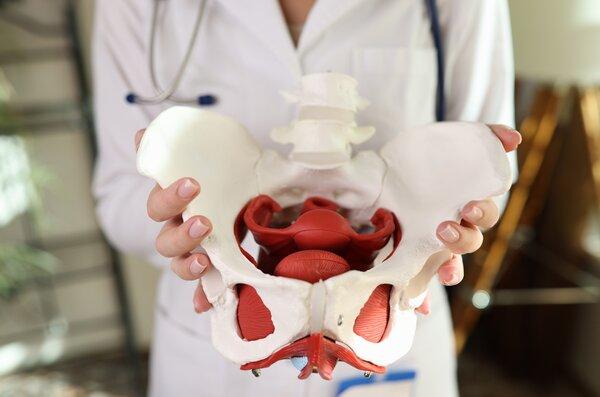
(Note: Some of the links in this post are affiliate links, and we will be compensated when you make a purchase by clicking through our links at no additional cost to you.)
The pelvic floor frequently receives less attention than other body parts in discussions about health and wellness. Its significance, however, cannot be emphasized. Whether you’re a fitness fanatic, a new mother, or someone who has pelvic floor problems, it’s critical to comprehend the timing for developing this important set of muscles. Therefore, let’s explore the nuances of pelvic floor strengthening and respond to the crucial query: How long does it take to strengthen pelvic floor?
Table of Contents
Understanding the Pelvic Floor:
The pelvic floor, often dubbed the body’s unsung hero, is a complex and intricate web of muscles, ligaments, and tissues situated at the base of the pelvis. Think of it as a hammock that cradles and supports vital organs like the bladder, uterus, and rectum. This network of muscles is not merely a passive foundation; it’s an active participant in a myriad of bodily functions that are essential for overall well-being.
At its core, the pelvic floor serves as the guardian of continence. The muscles work in harmony to control the release of urine and feces, playing a crucial role in maintaining bowel and bladder function. Imagine the precision required for a simple act like laughing without the fear of an unexpected leak—this precision is orchestrated by the pelvic floor.
Beyond its role in continence, these muscles are the unsung architects of spinal support. They form a vital part of the deep core muscles that contribute to maintaining an upright posture and supporting the spine. A strong and well-functioning pelvic floor is integral to a stable and balanced body, influencing everything from the way we stand to the efficiency of our movements.
Delving into the realm of intimacy, the pelvic floor also plays a pivotal role in sexual function. The muscles of the pelvic floor contribute to arousal, orgasm, and overall sexual satisfaction. They are, quite literally, the foundation of a healthy and fulfilling sexual experience. Understanding and appreciating the significance of the pelvic floor in this context highlights its relevance not just for physical health but for emotional and relational well-being.
However, like any intricate system, the pelvic floor is not immune to challenges. Pregnancy, childbirth, aging, and certain medical conditions can place stress on these muscles, leading to issues such as incontinence or pelvic organ prolapse. Hence, the need to actively care for and strengthen the pelvic floor becomes paramount.
>>> No More Leaks: Must-Read Urinary Incontinence Books
Factors Influencing Pelvic Floor Strength:
Age stands as a silent conductor orchestrating the symphony of changes within the human body, and the pelvic floor is no exception to its influence. As we age, the muscles that constitute the pelvic floor can undergo alterations in structure and tone. Collagen, a protein responsible for the elasticity of tissues, gradually diminishes with age, affecting the suppleness of these muscles. Moreover, hormonal fluctuations, particularly in women during menopause, can bring about a decline in estrogen levels, further impacting the integrity of the pelvic floor. These age-related changes may translate to a longer journey in strengthening the pelvic floor, demanding a more patient and persistent approach.
The overarching umbrella of overall health casts a significant shadow on the timeline for pelvic floor strengthening. Individuals with pre-existing health conditions such as obesity or chronic illnesses may find that their pelvic floor muscles bear the brunt of these challenges. Excess weight, for example, places additional stress on the pelvic region, potentially impeding the effectiveness of exercises aimed at strengthening these muscles. Conversely, those who prioritize their general health through a balanced diet and regular exercise are likely to witness a more responsive pelvic floor. The interconnectedness of bodily systems means that holistic well-being is not just a lofty ideal but a tangible factor influencing the pace of pelvic floor strengthening.
Lifestyle choices emerge as key players in the dynamics of pelvic floor health. A sedentary lifestyle, characterized by prolonged periods of sitting and minimal physical activity, can be a formidable adversary in the quest for a robust pelvic floor. The lack of movement compromises blood circulation to the pelvic region and weakens the muscles over time. Contrastingly, individuals who engage in regular physical activity, incorporating exercises that target the pelvic floor, are laying the groundwork for a more efficient and responsive muscular network. The saying “use it or lose it” is particularly pertinent here—regular activation of these muscles is essential for their maintenance and strengthening.
Specific life events, such as pregnancy and childbirth, carve unique imprints on the pelvic floor landscape. The incredible feat of carrying and delivering a baby places immense strain on these muscles. Pregnancy hormones contribute to the relaxation of ligaments and tissues in preparation for childbirth, potentially leading to temporary weakness in the pelvic floor. Postpartum, the pelvic floor may require dedicated attention to regain strength and resilience. Additionally, individuals dealing with pelvic floor disorders, such as pelvic organ prolapse or incontinence, may find that their journey to pelvic floor strength demands a tailored approach, involving guidance from healthcare professionals and specialized exercises.
Exercises for Pelvic Floor Strengthening:
Now that we have a foundation, let’s explore the exercises that can aid in pelvic One of the quintessential exercises in this realm is the Kegel exercise. Named after Dr. Arnold Kegel, these exercises focus on contracting and relaxing the pelvic floor muscles. The simplicity of Kegels belies their effectiveness—they can be discreetly performed at any time, making them a convenient addition to daily routines. To engage in a Kegel exercise, one can start by identifying the pelvic floor muscles (as if stopping the flow of urine midstream) and then contracting and holding these muscles for a few seconds before releasing. The key to success with Kegels lies in consistency; incorporating them into daily life gradually builds strength over time.
Squats, a compound exercise targeting multiple muscle groups, extend their benefits to the pelvic floor. As one descends into a squat, the pelvic floor muscles are engaged to provide stability and support. Squats not only contribute to pelvic floor strength but also promote overall lower body muscle development. However, it’s crucial to maintain proper form during squats to prevent strain on the pelvic floor. Consulting with a fitness professional to ensure correct technique is a prudent step for those new to this exercise.
Bridges, a floor exercise that involves lifting the hips toward the ceiling, also emerges as a valuable addition to pelvic floor workouts. As the hips ascend, the pelvic floor muscles are activated, working in conjunction with the glutes and lower back muscles. The controlled movement of bridges provides a targeted workout for the pelvic floor, aiding in both strength and flexibility. Gradually increasing the duration and repetitions of bridge exercises contributes to progressive improvement.

Pelvic tilts are another gem in the treasure trove of pelvic floor exercises. This exercise involves tilting the pelvis forward and backward while lying on the back, engaging the abdominal and pelvic floor muscles. Pelvic tilts are particularly beneficial for individuals seeking to enhance their awareness of pelvic alignment and control. As with any exercise, the emphasis is on precision and controlled movement to derive maximum benefit.
Consistency serves as the cornerstone of any effective exercise routine, and pelvic floor exercises are no exception. Regularity in performing these exercises is paramount for noticeable and lasting results. A dedicated commitment to a pelvic floor exercise regimen, ideally incorporating a variety of exercises to target different muscle groups, fosters a resilient and responsive pelvic floor.
Recognizing the individuality of each person’s body and health status, seeking professional guidance is a prudent step in the journey to pelvic floor strength. Healthcare professionals, particularly pelvic floor physical therapists, possess the expertise to offer personalized advice tailored to an individual’s unique needs and challenges. These professionals can assess muscle function, provide specific exercises based on individual capabilities, and offer guidance on proper technique. In cases where individuals are dealing with pelvic floor issues or have recently given birth, the expertise of a healthcare professional becomes even more valuable in navigating a safe and effective path toward pelvic floor strength.
Timeline for Pelvic Floor Strengthening:
The timeline for pelvic floor strengthening is inherently individual, influenced by factors ranging from age and overall health to lifestyle and the presence of specific conditions. It requires patience, commitment, and an understanding that growth occurs at its own pace.

For beginners venturing into the realm of pelvic floor exercises, the initial stages may be marked by a subtle yet perceptible transformation. In the first few weeks, individuals often notice heightened awareness of their pelvic floor muscles and a nascent sense of control. This is a crucial phase where the muscles are awakening, responding to the new stimuli introduced through exercises like Kegels, squats, bridges, and pelvic tilts.
As the weeks progress into months, the trajectory of improvement becomes more pronounced. Consistency is the linchpin during this period. Regular engagement of the pelvic floor muscles through exercises contributes to muscle memory, gradually enhancing both strength and endurance. Correct technique is of paramount importance; it ensures that the muscles are targeted effectively, minimizing the risk of strain or injury. Those who adhere to a well-structured routine, combining various exercises and paying attention to form, are likely to witness tangible advancements in pelvic floor strength.
The gradual increase in exercise intensity becomes a natural progression in the timeline for pelvic floor strengthening. As the muscles adapt to the initial exercises, incorporating variations and slightly intensifying the workload becomes instrumental in stimulating further growth. This phase requires a delicate balance—pushing the muscles just enough to challenge them without overwhelming or causing undue stress. It’s a nuanced dance between progression and respect for the body’s individual pace.
However, it’s crucial to recognize that individuals are not cut from the same cloth, and therefore, the timeline for pelvic floor strengthening is not a one-size-fits-all equation. Specific conditions, such as a history of pelvic floor disorders, pregnancy, or childbirth, may necessitate a more tailored approach. For example, postpartum individuals may experience a lengthier timeline due to the impact of childbirth on the pelvic floor. In such cases, patience becomes not just a virtue but a guiding principle in the journey to recovery and strength.
Moreover, the presence of medical conditions or chronic issues can influence the timeline. Individuals dealing with pelvic floor disorders or recovering from surgeries may require a more extended commitment to the strengthening process. In these instances, collaboration with healthcare professionals, including pelvic floor physical therapists, becomes invaluable. These experts can offer personalized guidance, monitor progress, and adjust the approach based on the individual’s response and needs.
Tips for Faster Results:
For those eager to expedite the pelvic floor strengthening journey, incorporating certain lifestyle changes can be beneficial.
First and foremost, your diet plays a pivotal role. A nutrient-rich, well-balanced diet not only fuels your overall health but also supports muscle growth, including the muscles of the pelvic floor. Ensure you’re getting an adequate intake of protein, essential vitamins, and minerals that contribute to muscle health. Foods rich in collagen, like bone broth, can be particularly beneficial for the connective tissues in the pelvic floor.
Hydration is another key player. Staying well-hydrated is crucial for muscle function and recovery. Water helps transport nutrients to cells and facilitates the removal of waste products. Dehydration, on the other hand, can lead to muscle cramps and stiffness, hindering your progress. Aim for the recommended daily water intake to keep your muscles, including those in the pelvic floor, functioning optimally.
Habits that strain the pelvic floor can impede your journey to strength. Heavy lifting, especially without proper form, can exert excessive pressure on these muscles. If weightlifting is part of your routine, prioritize proper technique and gradually increase weights to avoid strain. Chronic constipation is another culprit that can strain the pelvic floor. Incorporate fiber-rich foods and stay hydrated to promote regular bowel movements and alleviate unnecessary pressure on these muscles.
Mindfulness practices, such as yoga and stress management techniques, can be your allies in the quest for pelvic health. Stress and tension can manifest physically, impacting the pelvic floor muscles. Yoga, with its focus on breath and gentle movements, promotes relaxation and flexibility, benefiting the entire body, including the pelvic floor. Stress management techniques, whether through meditation, deep breathing, or other mindfulness practices, contribute to an overall sense of well-being, creating a conducive environment for pelvic floor strength.
In the pursuit of a stronger pelvic floor, patience is indeed a virtue. While the timeline varies, the key lies in consistency, proper technique, and a holistic approach to health. Whether you’re a new mom, an athlete, or someone simply prioritizing their well-being, understanding the nuances of pelvic floor strengthening empowers you to take charge of your health journey. So, embark on this path with dedication, and the rewards of a strengthened pelvic floor will undoubtedly follow.








